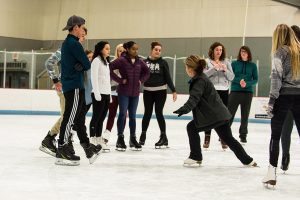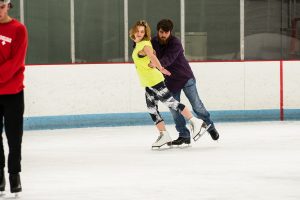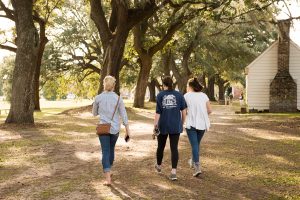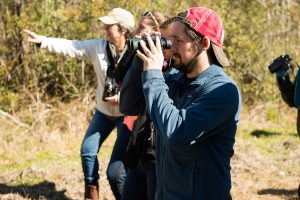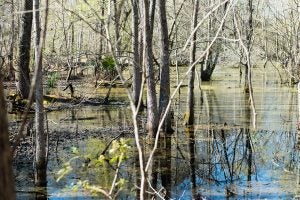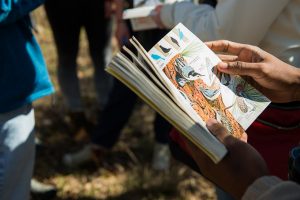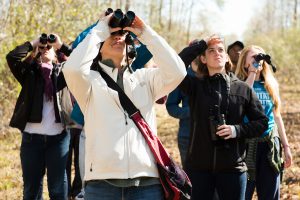It’s no secret that learning doesn’t just happen inside the classroom.
Students can get a lot out of being exposed to activities and lessons beyond the walls of campus. But you don’t have to venture halfway around the globe to get the benefit of learning in a different environment.
Here are five courses at the College of Charleston where professors leave the lectern and take students out into the wild to teach about everything from sociology and historic preservation to biology and even ice skating:
Photos by Reese Moore
1. Death and Dying
Sociology professor George Dickinson takes full advantage of the Holy City’s plethora of churchyard cemeteries, including the Circular Congregational Church and St. Phillip’s Episcopal Church, for his course CHLI 603: Dying, Death and Loss for the Child Life Graduate Program. An undergraduate version of the course, SOCY 336: Death and Dying, also makes an annual trek to local graveyards.
“It’s amazing to me given the history of Charleston that what you see here still stands,” says Dickinson, referencing the natural disasters and wars the Circular Congregational Church cemetery has survived since its founding in the late 1600s.
RELATED: How One Alumna Helped Create the Child Life Graduate Program
Field trips to the two cemeteries have been part of Dickinson’s curriculum since he began teaching the undergraduate course on death and dying in 1985. For the child life class, the excursion illustrates the history of death, which Dickinson lays out in three phases: “the living death” (1600-1830), “the dying of death” (1830-1945) and “the resurrection of death” (1945-present.) The cemetery tour also sets up a series of lectures on the business of dying, where the sociology professor delves into the world of funeral homes and burial.
“’Cemetery’ in Greek means ‘place of sleep’ or ‘sleeping place,’” Dickinson tells his child life students as they walk amid the uneven rows of headstones on a mild March afternoon.
The goal of the course is to offer a comprehensive overview of dying, death and bereavement including the social meanings of dying and death and the impact of culture, religion and ethnicity on end-of-life rituals. And a trip to these historic cemeteries — from their variety of headstones to the vast iconography marking the graves — offers tangible examples of those concepts.
Child life student Mary Ellen Dudash says that facing such a heavy topic head-on helps alleviate the stigma associated with death, a skill that will be invaluable for Dudash and her child life classmates as they navigate careers supporting children and their families facing illness and disability.
“It takes a difficult subject and makes it less awkward and more approachable,” says Dudash.
2. Biology of Fishes
There’s no better way to learn about scaly, gilled creatures than by rolling up your sleeves, slapping on waders and getting in the water to collect live fish specimens. The Biology of Fishes (BIOL 335) is a survey of the diversity and general biology of various kinds of fish, ranging from the most primitive jawless fish like hagfish and lamprey to the most specialized such as sea bass, pufferfish and tuna.
RELATED: Grad Goes From Biology of Fishes Student to Dolphin Trainer
And biology professor Tony Harold leverages the natural classroom outside the walls of the Grice Marine Laboratory on James Island (where his class is held) to help his students get the most out of the course. One such activity in February had Harold’s students using beach seines to collect and study live fish from the shallows of Grice Cove.
“We caught a variety of fish species, including silversides, anchovies, filefish, gobies, mullet and croakers,” says Harold.
When they weren’t scooping up these slippery little fish, Harold’s students were taking brief trips into Charleston Harbor to trawl for larger marine wildlife aboard Grice Marine Lab’s vessel, R/V Chamberlain.
“The lab also focuses on the recognition and identification of species with an emphasis on those that occur in freshwater, estuarine and marine habitats of the southeastern United States,” Harold says.
These activities offer students practical experience with a bit of adventure.
3. Ice Skating
South Carolina isn’t known for its wintry weather, but CofC doesn’t see the area’s perennially mild temperatures as a hurdle to introducing students to this classic winter sport. Thanks to the modern marvels of the indoor ice rink, the College’s students can learn the art of icy whirling and twirling at the Carolina Ice Palace in North Charleston.
Deborah Rosenbaum, a professional ice skating coach, teaches both beginning and intermediate ice skating courses through the College’s Department of Health and Human Performance as an option for P.E. Whether you skated as a child or are lacing up for the first time, the courses teach students how to step on the ice, balance on skates and use their blades to push forward, stop, turn and skate backwards safely. These skating building blocks allow students to advance to more complicated maneuvers in the intermediate class.
“The goal I set for the students is to learn how to be proficient at ice skating so that it can be a lifelong activity,” Rosenbaum says. “As the students advance in their skating skills, I encourage them to explore ice skating to music and learn how to present themselves in front of a small group or large audience. With a little imagination, they can make a connection with an audience and have fun with it.”
4. Interpretation in Historic Preservation
There’s no better way to learn about historic preservation than by being immersed in history. And that’s not a problem in Charleston. Special topics course HPCP290.02, Interpretation in Historic Preservation, leverages access to all the region’s old homes, buildings and gardens.
RELATED: Historic Preservation Students Drive Research on Classic Car
“We go to locally, regionally and nationally important sites that are owned by both the National Park Service, the National Trust, locally and regionally important institutions as well as private efforts,” says art and architectural history instructor James Ward. “We particularly focus on interpretation of outdoor museums or houses that involve some considerable elements of site and landscape.”
The McLeod Plantation Historic Site, a 37-acre site on James Island that dates back to 1851, is one of the places students visit for the course. Students get to study the preservation and interpretation of historic sites; in the case of McLeod, this includes the sprawling main home and furnishings, the homes of the enslaved and their descendants, farming facilities and the remnant gardens and grounds. The emphasis of the site is to tell the story of the “transition to freedom” from slavery to Reconstruction to contemporary times. Other sites students visit during the course include Caw Caw Interpretive Center, Drayton Hall, Middleton Place, Boone Hall Plantation and Charles Towne Landing.
“The students analyze how these sites are portrayed and develop a journal of what they see,” says Ward. “They are able to learn about historic interpretation first-hand in real-world settings.”
These field trips set up the students to apply their knowledge in the interpretation of Dixie Plantation, the College’s 930-acre property in Hollywood, South Carolina, that serves as a center for environmental research and historical discovery.
“Our major purpose is to develop a sense of how these thoughts might be incorporated in the interpretation and management of the College of Charleston’s premier site at Dixie,” says Ward.
5. Ornithology
Dixie Plantation is a whole world unto itself that offers a variety of learning experiences for students. Biology professor Melissa Hughes says Dixie and its myriad ecosystems — long leaf pine forests, wetlands, savannas, tidal marshes, as well as brackish, saltwater and fresh-water ponds — makes for an outstanding locale for her BIOL 333 (ornithology) class.
RELATED: Ornithology Students Take Advantage of Dixie Plantation’s New Field Research Stations
Once a week for a semester students get to comb the vast property to study all makes and models of birds. Students practice everything from bird census and recording to bird capture and handling. And as the season changes from cool to warm (the course is taught only in the spring), they get to observe physical and behavioral changes in the different species of birds.
“It’s a full immersion experience,” Hughes says. “At Dixie I have a variety of habitats right there and the students can really take more ownership.”
But this isn’t just a class about birds. The curriculum builds on scientific disciplines from biology, ecology and physiology. Birds are simply the vehicle for accessing those fields of study.
“We’re really trying to have an integrated view of the organism and being able to go out and see the birds and have that field experience is really critical to that,” says Hughes.















